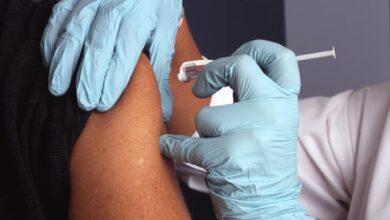A number of red-leaning states made news early this week by announcing an end to mandated masks in schools. Combined with the news of a COVID-19 vaccine that is likely to be available to kids under the age of five, many Americans are feeling more optimistic about the state of the pandemic.
Democratic governors in a number of states announced on Monday that they will be moving to roll back mask mandates, jumping ahead of what the federal government had recommended about the use of masks in schools and other public indoor spaces.
The governors that made these announcements on Monday included California’s Gavin Newsom, New Jersey’s Phil Murphy, Delaware’s John Carney, and Connecticut’s Ned Lamont. The easing of these restrictions come as the U.S. is beginning to see relief from the pervasive Omicron variant. While transmission is still high in most areas, the falling numbers are giving government and health officials reason for optimism.
Details of Mask Mandate Easing
Newsom said that California will let the indoor mask mandate expire on February 15. However, the mask mandate will still apply to unvaccinated individuals. California was one of the first states in the nation to issue a statewide mask mandate back in June of 2020. Counties will still retain the authority to keep these mask mandates in place. More information about how this will affect public schools will be announced shortly, according to state health officials.
Over on the East Coast, Delaware also announced that it will roll back its mask mandate in public and private K-12 schools and in other indoor areas on March 31. New Jersey Gov. Murphy said that he will lift the mandates in schools and childcare centers on March 7. Lamont said that he will recommend that his state of Connecticut terminate the statewide mask mandate in schools and childcare settings on February 28. However, Lamont said that schools can still decide at the local level to leave the restrictions in place.
Latest on COVID-19 Vaccine for Young Children
Children between the ages of six months and five years old may soon be eligible to receive a COVID-19 vaccine. However, this authorization process is taking a much different route than previous COVID-19 vaccines have taken.
Last week, Pfizer announced that it had submitted a request for authorization for the pint-sized vaccine to the U.S. Food and Drug Administration (FDA). This request for an emergency use authorization (EUA) will include a third dose of the primary vaccine regimen, making it different than what versions for the older population received.
Pfizer is justifying the third dose by saying the original two-dose regimen did not deliver the expected immunity to this age group. The pharmaceutical company plans to stay on course with the testing of the three-dose regimen and will submit the new data to the FDA in the next few months.
However, rather than wait until this data comes in, Pfizer is already instigating the EUA process without having access to this complete data set. The FDA’s independent vaccine adviser group is set to meet on February 15 to review the data and to make a recommendation on whether to grant the EUA. This means that parents will likely not know if the three-dose regimen will be the official recommendation until after they have already begun the vaccination process for their young children.
When Could the Vaccine be Available?
According to White House COVID-19 response coordinator Jeff Zients, the vaccine will be available as soon as it receives approval from both the FDA and the U.S. Centers for Disease Control and Prevention (CDC). This means that some of the nation’s youngest kids may be getting shots in arms by the end of the month. Zients said that the federal government has enough kid-size needles and other necessary supplies to roll this out quickly.
While the initial approval will only come for the standard two doses, Pfizer said that the third dose would come eight weeks after the second shot, if approved. According to Pfizer, while the vaccine provided sufficient protection for infants and toddlers up to the age of two years, the preschool-age groups did not see the same immune response out of the 3-microgram dose. This is why researchers are now looking at the feasibility of a third shot to complete the series and bring the protection up to what older children and adults have experienced.
To compare, the dose for the youngest age group is only one-third of the dose provided to children in the 5 to 11 age group. Additionally, this 3-microgram dose is a tenth of the size of the dose authorized for people ages 12 and older.
CDC Clarifies Uses of Boosters for Immunocompromised Individuals
The CDC is attempting to clear up some of the confusion surrounding the use of COVID-19 vaccine boosters for immunocompromised individuals. Late last week, the CDC said that it is recommending that these people get an additional booster, to equal four total shots, at least three months after the third shot. The previous recommendation was five months. These new recommendations apply to those moderately to severely immunocompromised people who are ages 12 and older.
The clarity comes as some of these individuals reported having difficulties getting the fourth shot at some clinics and pharmacies because of the confusion surrounding the guidance. According to the CDC, there are about 7 million Americans who would qualify for this fourth shot due to weakened immune systems.






